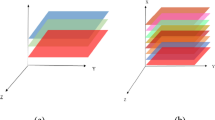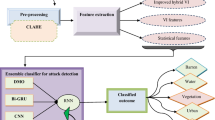Abstract
Hyperspectral remote sensing has a strong ability in information expression, so it provides better support for classification. The methods proposed to deal the hyperspectral data classification problems were build one by one. However, most of them committed to spectral feature extraction that means wasting some valuable information and poor classification results. Thus, we should pay more attention to multi-features. And on the other hand, due to extreme requirements for classification accuracy, we should hierarchically explore more deep features. The first thought is machine learning, but the traditional machine learning classifiers, like the support vector machine, are not friendly to larger inputs and features. This paper introduces a hybrid of principle component analysis (PCA), guided filtering, deep learning architecture into hyperspectral data classification. In detail, as a mature dimension reduction architecture, PCA is capable of reducing the redundancy of hyperspectral information. In addition, guided filtering provides a passage to spatial-dominated information concisely and effectively. According to the stacked autoencoders which is a efficient deep learning architecture, deep-level multi-features are not in mystery. Two public data set PaviaU and Salinas are used to test the proposed algorithm. Experimental results demonstrate that the proposed spectral–spatial hyperspectral image classification method can show competitive performance. Multi-feature learning based on deep learning exhibits a great potential on the classification of hyperspectral images. When the number of samples is 30 % and the iteration number is over 1000, the accuracy rates for both of the two data set are over 99 %.






Similar content being viewed by others
References
Azar AT, Hassanien AE (2015) Dimensionality reduction of medical big data using neural-fuzzy classifier. Soft Comput 19(4):1115–1127
Baassou B, He M, Mei S (2013) An accurate SVM-based classification approach for hyperspectral image classification. In: 21st International conference on geoinformatics, geoinformatics 2013, Kaifeng, China, June 20–22, 2013, pp 1–7
Bengio Y, Lamblin P, Popovici D, Larochelle H (2007) Greedy layer-wise training of deep networks. Adv Neural Inf Process Syst 19:153
Chang C-C, Lin C-J (2011) LIBSVM: a library for support vector machines. ACM TIST 2(3):27
Chen Y, Lin Z, Zhao X, Wang G, Yanfeng G (2014) Deep learning-based classification of hyperspectral data. IEEE J Sel Top Appl Earth Obs Remote Sens 7(6):2094–2107
Chen Y, Zhao X, Jia X (2015) Spectral–spatial classification of hyperspectral data based on deep belief network. IEEE J Sel Top Appl Earth Obs Remote Sens 8(6):2381–2392
Falco N, Benediktsson JA, Bruzzone L (2014) A study on the effectiveness of different independent component analysis algorithms for hyperspectral image classification. IEEE J Sel Top Appl Earth Obs Remote Sens 7(6):2183–2199
Fauvel M, Benediktsson JA, Chanussot J, Sveinsson JR (2008) Spectral and spatial classification of hyperspectral data using SVMs and morphological profiles. IEEE Trans Geosci Remote Sens 46(11):3804–3814
He K, Sun J, Tang X (2013) Guided image filtering. IEEE Trans Pattern Anal Mach Intell 35(6):1397–1409
Huang X, Zhang L (2013) An SVM ensemble approach combining spectral, structural, and semantic features for the classification of high-resolution remotely sensed imagery. IEEE Trans Geosci Remote Sens 51(1):257–272
Kang X, Li S, Benediktsson JA (2014) Spectral–spatial hyperspectral image classification with edge-preserving filtering. IEEE T Geosci Remote Sens 52(5):2666–2677
Ko L-W, Kuo B-C, Lin C-T (2005) An optimal nonparametric weighted system for hyperspectral data classification. In: Proceedings of the knowledge-based intelligent information and engineering systems, 9th international conference, KES 2005, Melbourne, Australia, September 14–16, 2005, Part I, pp 866–872
Li J, Bioucas-Dias JM, Plaza A (2013) Spectral–spatial classification of hyperspectral data using loopy belief propagation and active learning. IEEE Trans Geosci Remote Sens 51(2):844–856
Li J, Bruzzone L, Liu S (2015) Deep feature representation for hyperspectral image classification. In: 2015 IEEE international geoscience and remote sensing symposium (IGARSS 2015), Milan, Italy, July 26–31, 2015, pp 4951–4954
Liu P, Sun S, Li G, Xie J, Zeng Y (2012) Unsupervised change detection on remote sensing images using non-local information and Markov random field models. In: 2012 IEEE international geoscience and remote sensing symposium (IGARSS). IEEE, pp 2245–2248
Lunga D, Prasad S, Crawford MM, Ersoy O (2014) Manifold-learning-based feature extraction for classification of hyperspectral data: a review of advances in manifold learning. IEEE Signal Process Mag 31(1):55–66
Mavrovouniotis M, Yang S (2015) Training neural networks with ant colony optimization algorithms for pattern classification. Soft Comput 19(6):1511–1522
Melgani F, Bruzzone L (2004) Classification of hyperspectral remote sensing images with support vector machines. IEEE Trans Geosci Remote Sens 42(8):1778–1790
Ouma YO, Tetuko J, Tateishi R (2008) Analysis of co-occurrence and discrete wavelet transform textures for differentiation of forest and non-forest vegetation in very-high-resolution optical-sensor imagery. Int J Remote Sens 29(12):3417–3456
Pearson K (1901) On lines and planes of closest fit to systems of points in space. Philos Mag 2(11):559–572
Pesaresi M, Gerhardinger A, Kayitakire F (2008) A robust built-up area presence index by anisotropic rotation-invariant textural measure. IEEE J Sel Top Appl Earth Obs Remote Sens 1(3):180–192
Quesada-Barriuso P, Arguello F, Heras DB (2014) Spectral–spatial classification of hyperspectral images using wavelets and extended morphological profiles. IEEE J Sel Top Appl Earth Obs Remote Sens 7(4):1177–1185
Richards JA, Jia X (2013) Remote sensing digital image analysis: an introduction. Springer, Berlin
Rumelhart DE, Hinton GE, Williams RJ, Hinton GE (1986) Learning representations by back-propagating errors. Nature 323:533–536
Sun L, Wu Z, Liu J, Xiao L, Wei Z (2015) Supervised spectral–spatial hyperspectral image classification with weighted Markov random fields. IEEE Trans Geosci Remote Sens 53(3):1490–1503
Tan CC, Eswaran C (2008) Reconstruction of handwritten digit images using autoencoder neural networks. In: Canadian conference on electrical and computer engineering, 2008 (CCECE 2008), pp 000465-000470
Tarabalka Y, Benediktsson JA, Chanussot J, Tilton JC (2010) A multiple classifier approach for spectral–spatial classification of hyperspectral data. In: Proceedings of the IEEE international geoscience & remote sensing symposium (IGARSS 2010), July 25–30, 2010, Honolulu, Hawaii, USA, pp 1410–1413
Vincent P, Larochelle H, Bengio Y, Manzagol P-A (2008) Extracting and composing robust features with denoising autoencoders. In: Proceedings of the 25th international conference on machine learning (ICML’08), pp 1096–1103
Wen J, Tian Z, Liu X, Lin W (2013) Neighborhood preserving orthogonal pnmf feature extraction for hyperspectral image classification. IEEE J Sel Top Appl Earth Obs Remote Sens 6(2):759–768
Xia J, Du P, He X, Chanussot J (2014) Hyperspectral remote sensing image classification based on rotation forest. IEEE Geosci Remote Sens Lett 11(1):239–243
Yuan H, Tang YY (2016) Spectral–spatial shared linear regression for hyperspectral image classification. IEEE Trans Cybern PP(99):1–12
Acknowledgments
This study is supported by the National Natural Science Foundation of China (Nos. 41471368 and 41571413).
Author information
Authors and Affiliations
Corresponding author
Ethics declarations
Conflict of interest
All authors declare that they have no conflict of interest.
Ethical standard
This article does not contain any studies with human participants or animals performed by any of the authors.
Additional information
Communicated by V. Loia.
Rights and permissions
About this article
Cite this article
Wang, L., Zhang, J., Liu, P. et al. Spectral–spatial multi-feature-based deep learning for hyperspectral remote sensing image classification. Soft Comput 21, 213–221 (2017). https://doi.org/10.1007/s00500-016-2246-3
Published:
Issue Date:
DOI: https://doi.org/10.1007/s00500-016-2246-3




